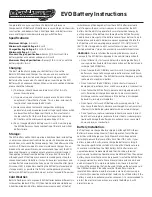
3-16
Return to
Section Topics
2308-900-01 Rev. A / July 2008
Section 3: Pulse Current Measurements
Model 2308 Portable Device Battery/Charger Simulator User’s Manual
SENSe[1]:PulseCURrent:SEARch <b>
Applies to battery channel (#1)
SENSe2: PulseCURrent:SEARch <b>
Applies to charger channel (#2)
See
Using FAST, SEARch, and DETect
for detailed usage information.
SENSe[1]: PulseCURrent:DETect <b>
Applies to battery channel (#1)
SENSe2: PulseCURrent:DETect <b>
Applies to charger channel (#2)
See
Using FAST, SEARch, and DETect
for detailed usage information.
SENSe[1]:PulseCURrent:TimeOUT <NRf>
Applies to battery channel (#1)
SENSe2: PulseCURrent: TimeOUT <NRf>
Applies to charger channel (#2)
See
Using FAST, SEARch, and DETect
for detailed usage information on properly setting the
TimeOUT variable.
Using FAST, SEARch, and DETect
Use the
FAST
command to have the quickest response for pulse current measurements triggered
by the measurement commands (for example,
MEASure
,
READ
or *
TRG)
. Note that when you
use the
FAST
command, there is no indication that the instrument is correctly configured for
detecting pulses until a measurement command is sent. When the trigger level is set, use the
SEARch
command to retain quick responses to measurement commands and to ensure that the
instrument is configured correctly for detecting pulses. Use the
DETect
command to ensure that
the unit is configured correctly and can read the pulse before sending a measurement command.
Use FAST, SEARch, and DETect to control how background readings are taken. A background
reading is a measurement taken by the power supply between user triggered readings. The
selected function dictates how background readings are taken between user triggered readings.
For pulse current, a background reading involves looking for the pulse and optionally generating a
reading for the user. The various settings of
SEARch
,
FAST
, and
DETect
allow the user to fine
tune the function. This enables the function to perform the desired background readings (if any)
between user triggered readings. The default settings (
FAST:OFF
,
SEARch:ON
, and
DETect:OFF
) allow the pulse current background readings to be taken. If no pulse is present, the
setting of TimeOUT affects how responsive the supply is to bus commands. If a pulse is present,
the search time affects how responsive the supply is to bus commands (refer to
Figure 3-5
).
Table
3-4
contains the available settings for
FAST
,
SEARch
, and
DETect
commands and a description
of the resulting action.
In order to efficiently use
FAST
,
SEARch
, and
DETect
for pulse current measurements, the user
must know the approximate period of the expected pulse. TOUT (TimeOUT) specifies the timeout
length for searching for the pulse (default setting is 1 second). When the TOUT value is reached,
“NO PULSE” is displayed (top line of the front-panel display) if default settings for FAST, SEARch,
and DETect are used. See
Table 3-4
for what is shown on the front-panel display if the default
settings are not used. Set the value for TOUT as follows:
TOUT
= search Time + Period
Search Time
= time allowed for detection of a pulse edge
Period
= time between consecutive pulse edges
In other words, the timeout value should be set to allow sufficient time for detection of the pulse if
the edge is just missed. In
Figure 3-5
, (P) is the point to start looking for the pulse. Since the rising
edge was just missed, (D) will be the first detectable rising edge. If the timeout is less than search
time, a pulse trigger time out (due to TOUT) may occur. Therefore, if the period = 0.4 seconds, a
good TOUT value would be 0.5 seconds. A similar method for selecting a TOUT value would be to
use a value equal to 105% of the expected pulse period.
Содержание 2308
Страница 2: ......
Страница 12: ...This page left blank intentionally...
Страница 32: ...This page left blank intentionally...
Страница 106: ...This page left blank intentionally...
Страница 140: ...This page left blank intentionally...
Страница 208: ...This page left blank intentionally...
Страница 209: ...Appendix A Error and Status Messages In this Appendix Error and status message definitions A 2 Topic Page...
Страница 220: ...This page left blank intentionally...
















































